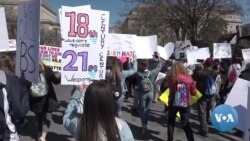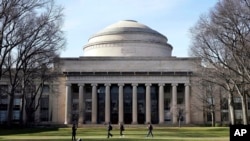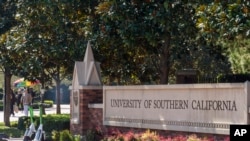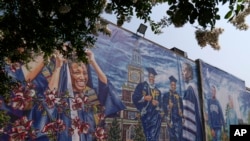Student Union
Plenty of Signs Surging Youth Vote Will Play Major Role in 2020 US Election
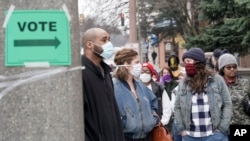
Millennials and GenZers have seen more than most generations in their young lifetimes: a terrorist attack on U.S. soil in 2001, two economic crashes and record unemployment, extreme weather events, divisive politics and a global pandemic.
And most recently, social unrest in response to the death of George Floyd, an African American man who died after being restrained by Minneapolis police.
“Millennials Don’t Stand a Chance,” economics journalist Annie Lowrey wrote for The Atlantic in April.
Yet there are plenty of signs that young Americans could play a major role in the 2020 election, helping to determine the outcome of the race between Republican President Donald Trump and Democratic challenger Joe Biden, as well as political control of Congress, and beyond. Their record turnout in the 2018 midterm elections, signs of political activism, and a handful of issues being used as a rallying cry, including soaring college debt, health care and climate change, stand as evidence.
“Young people can decide elections, and their participation is central to our politics. Expanding the electorate and addressing inequities in youth voting is a crucial task for strengthening democracy,” according to the Center for Information and Research on Civic Learning and Engagement (CIRCLE) based at Tufts University in Massachusetts.
While younger generations mimic their elders when they were young — by not engaging at the voting booth — the 2018 midterms saw an upsurge in participation.
Election involvement
Millennial voting nearly doubled between 2014 and 2018 — from 22% to 42% — according to demographer Richard Fry at the Pew Research Center in Washington. Thirty percent of Gen Zers eligible to vote turned out in the first midterm elections of their lives. And for the first time in a midterm election, more than half of Gen Xers reported they had voted, Pew reported.
“This 2020 election cycle is particularly interesting because, for the first time in almost over 25 years, we’re moving from a midterm election where young people’s participation dramatically increased,” Abby Kiesa, CIRCLE’s director of impact, said.
“Now there are 47 million 18- to 29-year-olds who are eligible to vote in the 2020 election, and 15 million of them have turned 18 since the last presidential election,” Kiesa said.
While young people — millennials born 1985-1995, GenZers born in 1996 onward — are casually viewed as a homogeneous group of like-minded thinkers, research shows otherwise.
In the 2018 midterm elections, two-thirds of all young voters age 18-29 supported the Democratic candidate for Congress. That’s the widest party gap in the past 25 years, CIRCLE said.
And the 2020 election will happen amid a huge demographic shift, said Jesse Barba, senior director of external affairs at Young Invincibles, a youth voting and political advocacy group “to expand economic opportunity for our generation.”
The U.S. population is poised to move from majority white to majority minority, or mostly non-white voters, by 2045, according to Brookings Institution.
“This would be the first time in history where nonwhite people make up the largest electorate,” Barba said. “I think for so long people have been talked down to rather than included and talked with, so … any candidate who wanted to motivate and mobilize young people should have tried to speak about four or five key things.”
Key issues to young voters
Those key issues include college debt, affordable health care, expanding voter rights, gun violence, immigration, climate change and economy, he said.
“I think the public health crisis has now put two issues top-of-mind squarely for young people, and that’s economy and mental health,” Barba said, citing record unemployment driven by the coronavirus pandemic and widespread shutdowns of businesses, such as restaurants, bars and retail, which all typically employ younger people and seldom provide benefits.
“Many of those young people [are] disproportionately working in industries that are hit the hardest, right? So not only are they losing their jobs, they’re also at risk of losing that job-based health coverage or inability to afford their own individual plans,” Barba said.
“Healthcare probably is huge for me,” said Paul Haarstick of Vergas, Minnesota, who lost his health care benefits when he pivoted from a corporate job with corporate benefits to be an entrepreneur. Haarstick is also the county director for Otter Tail County in the Democratic Farmer Labor Party.
“Since our healthcare system is tied with ‘employment equals health insurance,’ … there’s no real good second option for an entrepreneur. You pay more for healthcare and you get worse coverage.”
Health care costs added to student debt costs are subtracted from salaries that can’t cover everything.
“Is it fair that an entire generation lost out on a decade’s worth of wages in 2010 in the Great Recession?” he added, referring to the banking collapse in 2008 and resultant economic downturn.
For college graduates at the time, especially those carrying student debt, jobs were hard to come by.
“Is it fair that an entire generation press ‘pause’ on family planning and had to crawl back to mom and dad’s house? No,” he said. “So I think that is a constant reminder for young people when they walk into the ballot box in November.”
Former pastry chef and author Alechia Dow, who writes Young Adult sci-fi featuring black girls, tweeted about student debt this week, along with hundreds of others who share laments about debt burden on Twitter.
“It’s my dream to one day own a house, with brightly painted walls and a big kitchen with an island,” she wrote. “But then I look at my student loan debt, and that’s as much as a house, so I know that dream is impossible.”
Young white males
One voting bloc that takes a different path are young, white, male voters, statistics show. “They form a sizable and sometimes disproportionate swath of the American electorate,” CIRCLE said.
Young white men voted at a higher rate than young Latino and black men, according to CIRCLE’s analysis of the 2018 Current Population Survey data, which is produced by the Bureau of Labor Statistics and the Census Bureau. In the last presidential election, the bloc also preferred Donald Trump over Hillary Clinton by 22 percentage points.
Young men of color and young women, conversely, preferred Clinton, by from 15 to 60 percentage points, CIRCLE said.
And in some key swing states — Iowa, Ohio and New Hampshire — young white men make up a larger share of the population compared to national averages.
Five months before the U.S. general election in November, the pandemic continues, unemployment remains high and many young people, especially people of color, are advocating for racial and social justice after the death of George Floyd and other similar incidents and inequities in American society.
“You can tweet about it. You can hashtag about it. You can be upset about it and share the video,” said Markus Tarjamo, a student and Democratic National Convention delegate candidate from suburban Washington. “But until we start going and taking political power, not much will change.”
CIRCLE’s Kiesa says that attitude could spark other young people to activate at the polls.
“And so we’re really interested in following how much that youth enthusiasm, how much that energy from young people and reaching out to other young people, is going to carry in to 2020,” Kiesa said.
Bronwyn Benito and Esha Sarai contributed to this report.
See all News Updates of the Day
Malaysian official: Schools can’t turn away from global tensions

Zambry Abdul Kadir, Malaysia’s higher education minister, said protests spreading across universities in the United States show that schools can’t ignore political tensions.
Helen Packer, reporting in Times Higher Education, said the minister reminded educators that universities are key in the development of leaders, individuals and societies. (April 2024)
Social media breaks are difficult, but necessary

Between online classes, maintaining social connections and working on projects, college students can have a hard time disengaging from the demands of technology.
In Florida International University’s PantherNOW, Ariana Rodriguez offers strategies for taking a break from social media. (April 2024)
- By Melos Ambaye
Many master's degrees aren't worth the investment, research shows

Nearly half of master's degrees have a negative financial return, according to new research by the Foundation for Research on Equal Opportunity, an economic research organization.
The study indicates that many graduate degree programs do not increase lifetime earnings enough to be worth it.
While 23% of bachelor’s degree programs yield a negative financial return on investment, 43% of two-year degrees and master’s degrees fail to deliver a return, according to the study by Preston Cooper, a senior fellow at FREOPP.
Cooper assessed the return on investment for 53,000 degree and certificate programs to determine whether a student’s lifetime earnings outweigh program costs and the risk of not completing their degree.
His findings show that a student’s field of study was the overriding indicator of return on investment at the undergraduate and graduate level.
Engineering, computer science and nursing bachelor’s degrees have high financial returns on investment, while programs in education, fine arts, psychology and English usually have low returns.
Graduate degrees in medicine and law tend to have strong payoffs. But a large share of master’s programs, including the MBA, frequently have low payoffs, according to Cooper.
Although workers with master’s degrees earn 16% more than those with only bachelor’s degrees, Cooper says the figure fails to account for students who had “higher preexisting earnings potential.”
“MBA students typically have high preexisting earnings potential, having often chosen high-ROI undergraduate majors such as finance and economics,” Cooper writes. “So the MBA adds little value on top of that.”
The study indicates that high starting salaries are predictors of high returns on investment. Degrees with starting salaries of $57,000 a year or more deliver the best lifetime returns.
But the return on investment of a degree can vary depending on the educational institution.
“Students interested in fields with low average pay can still find some schools that do well transforming those fields of study into high-paying careers,” Cooper writes.
The quality of an institution also matters, said William Tierney, professor emeritus of higher education at the University of Southern California.
“An MBA from Harvard is a likely ticket to a good job,” Tierney told VOA. “An MBA from the University of Phoenix, less so.”
But students pursue graduate programs for more than just financial reasons.
“Some degrees open up careers in fields that students may enjoy, such as in the performing arts,” Robert Kelchen, head of educational leadership at the University of Tennessee, Knoxville, told VOA.
“Others can help gain access to social networks or simply help students learn about a topic that is of interest,” Kelchen added.
Cooper told VOA that it might make sense for students in degree programs with low returns on investment to switch majors if they can still graduate on time.
He found the worst outcome for a student’s return on investment is dropping out of college “because they must pay for one or more years’ tuition and spend time out of the labor force.”
Lawmakers who fund higher education have a responsibility in ensuring “higher education delivers on its promise of economic mobility,” Cooper said.
Nearly a third of federal funding, including Pell grants and student loans, pays for higher education programs that fail to provide students with a return on investment, according to the study.
Cooper’s view is that “some schools should shut down low-ROI programs and reallocate institutional resources to programs with a better return.”
“There's definitely this narrative out there that higher education is always worth it, and you should always try to get that extra degree because it will increase your earnings,” he told VOA. “That's reinforced by colleges who make lofty promises regarding their graduate degree programs' outcomes, which all too often fall short.”
Harvard students end protest as school agrees to discuss Gaza conflict

Protesters against the war between Israel and Hamas were voluntarily taking down their tents in Harvard Yard on Tuesday after university officials agreed to discuss their questions about the endowment, bringing a peaceful end to the kinds of demonstrations that were broken up by police on other campuses.
The student protest group Harvard Out of Occupied Palestine said in a statement that the encampment "outlasted its utility with respect to our demands." Meanwhile, Harvard University interim President Alan Garber agreed to pursue a meeting between protesters and university officials regarding the students' questions.
Students at many college campuses this spring set up similar encampments, calling for their schools to cut ties with Israel and businesses that support it.
The Israel-Hamas war began when Hamas and other militants stormed into southern Israel on October 7, killing some 1,200 people and taking 250 hostages. Palestinian militants still hold about 100 captives, and Israel's military has killed more than 35,000 people in Gaza, according to Gaza's Health Ministry, which doesn't distinguish between civilians and combatants.
Harvard said its president and the dean of the Faculty of Arts and Sciences, Hopi Hoekstra, will meet with the protesters to discuss the conflict in the Middle East.
The protesters said they worked out an agreement to meet with university officials, including the Harvard Management Company, which oversees the world's largest academic endowment, valued at about $50 billion.
The protesters' statement said the students will set an agenda that includes discussions on disclosure, divestment, reinvestment and the creation of a Center for Palestine Studies. The students also said that Harvard has offered to retract suspensions of more than 20 students and student workers and back down on disciplinary measures faced by 60 more.
"Since its establishment three weeks ago, the encampment has both broadened and deepened Palestine solidarity organizing on campus," a spokesperson for the protesters said. "It has moved the needle on disclosure and divestment at Harvard."
Chinese students report interrogations, deportations at US airports
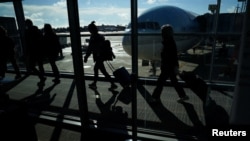
Academics from China are reporting increased scrutiny at U.S. airports, with valid visa holders being interrogated and turned away by Customs and Border Protection Agents.
Phones and laptops have been searched, and researchers have undergone extensive questioning about their work. One graduate student at Yale, who was midway through her PhD, was turned back at Dulles airport and banned from entering the U.S. for five years, according to The Guardian.




